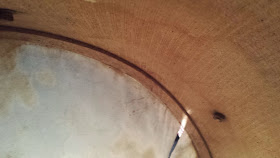A READER WROTE:
Hi. My name is Mike and I have a drum similar to the one you have posted in the link below (http://blog.fielddrums.com/2009/07/from-muleskinners-photo-gallery-big.html). I have attached some pictures. Can you help me identify it? There are no makers marks or labels anywhere.
It looks like it was a rope tension drum originally. Any idea what it might be worth?
http://blog.fielddrums.com/2009/07/from-muleskinners-photo-gallery-big.html
Thanks!
Mike
FD:
Mike,
Thanks for your email.
***
What are the dimensions?
What are the dimensions?
The paintings appear relatively new. The holes in the counterhoops suggest that they were part of a rope tensioning system.
The tensioning hardware might provide some clues.
Can you get photos of the interior?
Thanks.
Ellis
MIKE'S RESPONSE:
I haven't seen any scratches on the shell which makes me think the shell was painted when the tension hardware was added. There are holes in both hoops although some are filled in with wood plugs.
Both hoops are made of the same wood and seem to be the same age.
Thanks for your help so far.
What does the tack seem tell us about the age? Do you know if the drum is of an American origin?
FD:
Mike,
Prior to about 1860 or so, steambent drum shells had to be held together by tacks because the glues were not sufficiently developed to hold the overlapping portions of the bent drum shell together.
So the presence of tacks is evidence (not necessarily irrefutable proof) that the shell was manufactured prior to approximately 1860.
MIKE'S RESPONSE:
Would there be a way to prove it's age? Any idea of its value today?
FD:
As to proving a date of manufacture, no, not that I am aware of. My guess is that the drum in probably 19th century. As far as value, probably not much of a market for the drum. A few hundred dollars maybe. The demand for bass drums is very small. And 32” diameter bass drums have an even smaller demand. They’re just too big to fit comfortably into most collector’s usually limited display space. If you’re interested in selling the drum, you might consider eBay. I’ve bought many drums on eBay. You could try auction houses, but without substantiated provenance, I don’t think that there will be much interest. Also, the painting, as I said, looks too fresh which causes me to suspect it’s a relatively recent paint job. See some of the authentic mid-19th century emblazonments. They look old, worn, washed out colors. By contrast, your drum looks bright, as if it had been painting last week.
Also, the hole (see below) is perpendicular to the surface (or radial). Rope holes would have been at an angle (or would exhibit wear at an angle). It looks like there is a slight discoloration below the hole in the photo below. That could be wear or possibly from foot hardware (where the drum might have had a device attached to keep it from moving on the floor if the drum was used as a bass drum in an early drum kit).
How many holes are in the hoops? Are there about 10 or 12 holes in each counterhoop?
Also, since the eagle is aligned vertically perhaps it was meant to be seen from the head side of the drum rather than from a radial position. That would be consistent with the drum having been used as part of a drum kit and painted that way for that purpose.
A drum that size would have been used as a bass drum in a marching band or drum corps to provide the downbeat and keep soldiers in step while marching. Or it could have been part of a drum kit.
See, e.g., this single tension bass drum from the 1920’s, as well as a 14x28” Ludwig brand double tension bass drum from the same period, and a 1930’s Slingerland bass drum with similar hardware to yours.
And see this relatively new custom dixieland jazz band drum:
Are the tension rods perfectly evenly spaced around the drum shell? If not, that could be evidence of after-market installation.
Bottom line: Without actually seeing the drum, my sense is that the shell and hoops could be mid-19th century but the tensioning system is early 20th century. The paint job – who know? My guess is that it’s relatively recent.
I’ve copied Lee Vinson on this reply. He’s a knowledgable drum collector/historian. He might have some ideas. Also, I’m copying him on our prior email exchanges.
Best,
Ellis
LEE VINSON:
Thank you for including me in this conversation. Unless I hear from Mike, I don't know that I'll chime in as you've been quite thorough already and I agree with all of your points.
I do wonder who did the conversion. The tube lugs in the blurry pics look Stone-ish to me.
Perhaps someone sourced their parts there or maybe even Stone & Son was behind the work themselves?!? Seems like George Burt and his son would have been more reverent and restored such a drum rather than converted it for modern purposes, but who knows? It's only a thought. Certainly nothing conclusive but it's fun to daydream about!
Hope all is well with you.
-Lee
FD:
Mike,
I hate to be a nuisance but if you would send a lot more pics, in focus, Lee and I would greatly appreciate it. Many of the pics you sent were out of focus unfortunately. iPhone or other smart phone pics without flash will be fine. You have a very interesting drum and we'd like to get to the bottom of the mystery.
By the way, W. Lee Vinson is also looking at the pics. Lee is a collector/historian/performing percussion artist with his own website. See http://leevinson.com and see his collection at http://leevinson.com/gear.html.
I'd also like to send the pics to others (including performing percussionists with the Nashville Symphony - Sam Bacco; the Orlando Symphony - Mark Goldberg; and the Huntsville Symphony Orchestra - Terry Cornett, and other drum restorers - George Kubicek, and others) but I'd like to send them really good photos. The best way is for me to post the pics on my website.
So please send a lot of good in-focus pics so I can broaden the base of input concerning your drum.
Thank you.
Best,
Ellis
MIKE'S RESPONSE:
Hi Guys,
Here are some more photos. I was able to get a couple of photos of the inside and you can see the grain and tool markings.
Let me know if you need a pic of anything specific.
Cheers
Mike
LEE VINSON:
Hi Mike and Ellis,
Thank you for forwarding the pictures along. It's an interesting OLD drum with stories to tell, but I can't say that I any further insights beyond what Ellis has already offered up. Perhaps some of the other collectors out there with more expertise in 19th century rope drums would recognize something distinctive about the shell which could narrow things down a little further as far as date and origin are concerned, but I'm not seeing much to go from.
Thank you again for including me in the conversation! Hope all is well.
-Lee
MIKE'S RESPONSE:
Ellis,
I do not see any evidence of anything being clamped to either rim. I do remember the drum was being used as a coffee table when I first discovered in a cottage in Northern Ontario.
The mark is 6.5 inches wide and looks more like some type of stain on the skin.
Mike



















.jpg)


.jpg)















